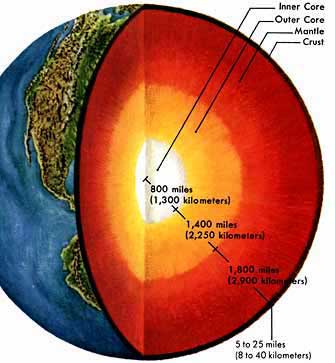Beneath the Earth's Crust
 |
|
|
Beneath
Earth's crust are the mantle, the outer core, and the inner core.
Scientists learn about the inside of Earth by studying how waves from
earthquakes travel through Earth.
World Book
illustration by Raymond Perlman |
Beneath Earth’s crust, extending down about 1,800 miles (2,900 kilometers), is a thick layer called the mantle. The mantle is not perfectly stiff but can flow slowly. Earth's crust floats on the mantle much as a board floats in water. Just as a thick board would rise above the water higher than a thin one, the thick continental crust rises higher than the thin oceanic crust. The slow motion of rock in the mantle moves the continents around and cause earthquakes, volcanoes, and the formation of mountain ranges.
At the center
of Earth is the core. The core is made mostly of iron and nickel and
possibly smaller amounts of lighter elements, including sulfur and oxygen. The
core is about 4,400 miles (7,100 kilometers) in diameter, slightly larger than
half the diameter of Earth and about the size of Mars. The outermost 1,400
miles (2,250 kilometers) of the core are liquid. Currents flowing in the core
are thought to generate Earth's magnetic field. Geologists believe the
innermost part of the core, about 1,600 miles (2,600 kilometers) in diameter,
is made of a similar material as the outer core, but it is solid. The inner
core is about four-fifths as big as Earth's moon.
Earth gets hotter toward the center. At the bottom of the continental crust,
the temperature is about 1800 degrees F (1000 degrees C). The temperature
increases about 3 degrees F per mile (1 degree C per kilometer) below the
crust. Geologists believe the temperature of Earth's outer core is about 6700
to 7800 degrees F (3700 to 4300 degrees C). The inner core may be as hot as
12,600 degrees F (7000 degrees C)--hotter than the surface of the sun. But,
because it is under great pressures, the rock in the center of Earth remains
solid.
